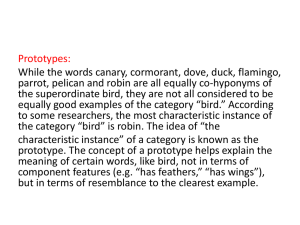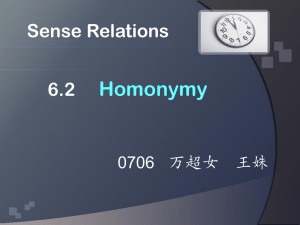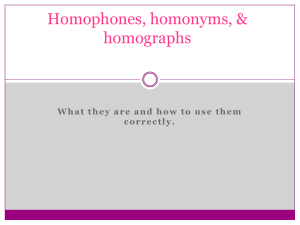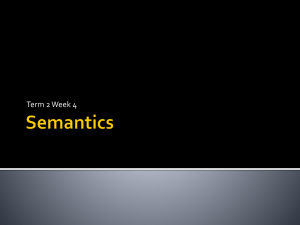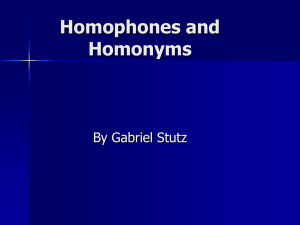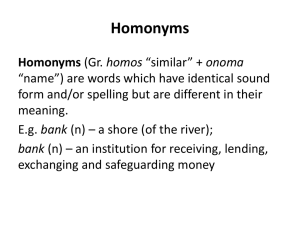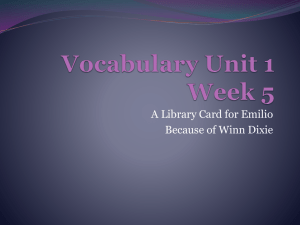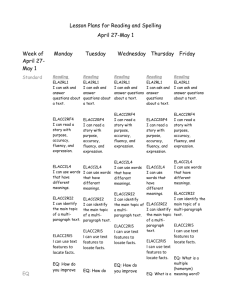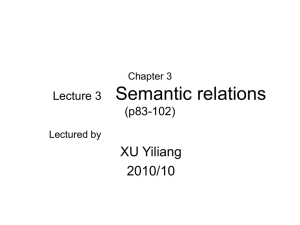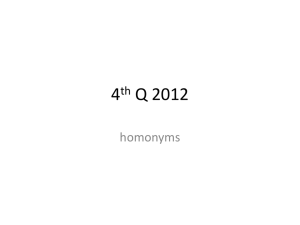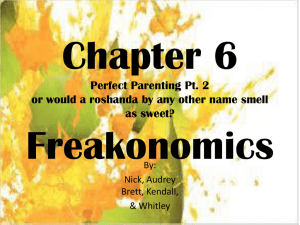PPT
advertisement
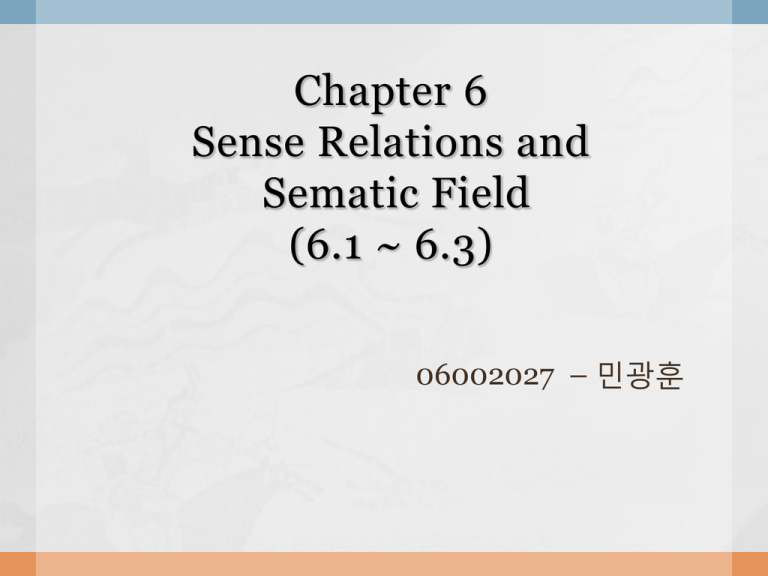
Chapter 6 Sense Relations and Sematic Field (6.1 ~ 6.3) 06002027 – 민광훈 Contents 6.1 Polysemy (다의성) 6.2 Homonymy (동음이의) 6.3 Synonymy (동의성) Words are arbitrary symbols and are indepen dent identities so far as their outer facet (spelling and pronunciation) is concerned. But semantically, all words are related in one way or another, hense sense relations The subjects are polysemy, homonymy, synony my, antonymy, hyponymy 6.1 Polysemy (다의성) An overwhelming majority of words are polysemous in modern English Many words have two, three senses, or more However, when a word is first coined, it is always monosemic. In the course of development, the same symbol must be used to express more meanings. The result is polysemy. 6. 1. 1 Two Approaches to Polysemy Diachronic approach & Synchronic approach 1. Diachronic approach Polysemy is assumed to be the result of growth and development of the semantic structure of one and same word. At the time when the word was created, it was endowed with only one meaning. This first mea ning is the primary meaning. With the advance of time, it took on more and more meaning. These later meanings are called derived meanings. For example) Face (1) The front of the head (2) the expression of the countenance (3) A surface of a thing (4) The side or surface that is marked, as of a clock, domino (5) The appearance; outward aspect; rsemblance (6)[CH idiom] dignity; presitige, as in lose / save face (7) The topography (of an area) (8) The functional and striking surface (of a tool, golf club..) (9)[colloquialism] effrontery, audacity (10) What is shown by the language of a document (11) [mining] the end of a tunnel (12)[typography] the type surface on which a letter is cut In many cases, the primary meaning became obsolete or disappeared altogether. Harvest The basic sense of word was ‘time of cutting’ Now it is used in the sense of ‘reaping and gathering the crops’ or ‘ ‘ a season’s yield of grain or fruit.’ Pain The basic meaning was ‘Penalty or punishment’ now This meaning is preserved only in such phrases as ‘pains and penalties’, ‘upon/under pain of’ The drived meanings ‘Suffering’, ‘great discomfort of the body or mind’ have become prevalent Synchronic approach Synchronically, polysemy is viewed as the coexistence of various meaning of the same word in a certain historical period of time in Modern English. In this way, the basic meaning of a word is the core of word-meaning called the central meaning. The derived meanings are second ary in comparison. But it does not necessarily mean that the secondary meanings are secondary in importance. There are cases where the central meaning has gradu ally diminished and one of the derived meanings has become dominant. For example ‘gay’ (1) Joyous and lively; merry ; happy (2) Bright ; brilliant (3) Given to social life and pleasure (4) Wanton ; licentious (5) Homosexual In both CCELD and LDCE, Sense (5) is arranged as No. 1, because it is rated as the most frequently used meani ng. 6. 1. 2 Two processes of Development radiation & concatenation. The development of word meaning from monosemy to polysemy follows two courses, known as radiati on and concatenation. They are closely related in many cases, they work to gether, complementing each other 1. radiation is a semantic process in which the pri mary meaning stands at the centre and secondary meanings proceed out of it in every direction. The meneaings are independent of one another, but can all be traced back to the central meaning. For example) Neck (1) that part of man or animal joining the head to the body. (2) that part of the garment (3) The neck of an animal used as food (4) A narrow part between the head and body ex) t he neck of a violin (5) The narrowest part of anything : bottle The primary meaning is (1). They don’t have the same meaning, but they are all related to the central meaning. 2. Concatenation, meaning ‘linking together’, is the semantic process in which the meaning of a word moves gradually away from its first sens e. in many cases, by succesive shifts, there is not sigh of connection between the final sense and the beginning term. For example) Treacle (1) Wild beast (2) Remedy for bites of venomous beasts (3) Antidote for poison or remedy for poison (4) effective remedy (BrE) (5) molasses (당밀) (1),(2) are entirely lost; (3),(4) are obsolete And only (5) remains common is use 6.2 Homonymy (동음이의) Homonyms(동음이의어) are generally defined as words different in meaning. But either identical both in sound and spelling or identical only sound or spelling 6.2.1 Type of homonyms Based on the degree of similarity, homonyms fall into three classes; Perfect homonyms(완전동의어), homographs(동형이의어), and homophones(이철어) 1. Perfect homonyms(완전동의어) Perfect homonyms are words identical both in sound and spelling, but diffifent in meaning - bear (n) : a large heavy animal bear (v) : to put with, endure - Date (n) : a kind of fruit (대추) date(n) : a boy or girl friend 2. Homographs(동형이의어) Homographs are words identical only in spelling but different in sound and meaning - bow /bau/ (n): bending the head as a greeting bow /(AmE) bou , (BrE) bəu/ (n) : the device used for shooting arrows - sow / (AmE) sou , (BrE) səu/ (v): : to scatter seeds sow /sau/ (n) : female adult pig 3. Homophones (이철어) Homophones are words identical only in sound but different in spelling and meaning - Dear /(AmE) diər, (BrE) diə/ (n) : a loved person Deer /(AmE) diər, (BrE) diə/ (n) : a kind of animal - Right /rait/ (a) : correct write /rait/ (v) : to put down on paper with a pen rite / rait/ (v): a ceremonial procedure 6.2.2 Origins of homonyms There are various sources of homonyms : 1. Change in sound and spelling gradually made some words identical long (adj) : not short, from lang(Old English) long (verb) : to want very much from langian(OE) 2. Borrowing. Many words of foreign origin coincide in sound and spelling with those of native origin. fair (n) : a market, borrowed from feria (L) fair (a) : pretty, from fæger (OE) 3. Shortening. Many shortened forms of words happen to be identical with other words in spelling or sound Ad (n) shortened from advertisement Add (v) to cause an increase 6.2.3 Differentiantion of Homonyms(동음이의 어) from Polysemants(다의어) Perfect homonyms(완전동의어) and polysemants(다의어) are fully identical with regard to spelling and pronunciation. One important criterion is to see their etymology(어원). Homonyms are from different sources whereas a polysemant is from the same sourece. The second principal consideration is semantic relatedness. The various meanings of a ploysemant are corrected to one central meaning. On the other hand, meanings of different homonyms have nothing to do with one another 6.2.4 Rhetoric Features of Homonyms As homonyms are identical in sound or spelling (particularly homophones) they are often employed to create pun(말장난)s for desired effect of, humor or ridicule In restaurant “You`re not eating your fish” the waitress said to him “Anything wrong with it? ” “Long time no sea” the man replied ‘Long time no see’ is usually said as a form of greeting. In this conversation, Customer criticize the bad quality of food in a humourous way. ‘long time no sea’ implies that ‘sea food kept for a long time is not fit for eating’ 6. 3 Synonymy (동의성) English is known for its abundant amount of synonyms. For example, in Beowulf, there were at least thirty-six words used for ‘hero’ and ‘prince’ , Seventeen expressions found used for ‘sea’ However, in present-day English, most of these terms have disappeared because we no longer need them 6. 3. 1 Definition of Synonyms Synonyms(동의어) can be defined as words different in sound and spelling but most nearly alike or exactly the same in meaning. But they denote similar concept, they differ in stylistic appropriateness(문체상의 어울 림). 6. 3. 2 Type of Synonyms 1. Absolute synonyms are words which are identical in meaning in all its aspects. scarlet-fever = scarlatina (세균성인후염) 2. Relative synonyms are similar or nearly the same in denotation stagger / reel/ totter (비틀거리다) stagger implies unsteady movement in a certain situation. reel suggest swaying like a drunken man. totter indicates the uncertain steps of an old person or infant. 6. 3. 3. Source of Synonyms Borrowing(차용) native : room , Foreign : Chamber 2. Dialects and regional English railway(BrE) , railroad(AmE) 3. Figurative and euphemistic use of words(비유적이고 완곡한 표현) occupation , walk of life (fig) 4. Coincidence with idiomatic expressions decide , make up one`s mind help , lend one a hand 1. 6. 3. 4 Discrimination of Synonyms Difference in denotation(명시적 의미의 차이). Synonyms may differ in the range and intensity of meaning. For example, timid and timorous are synonymous, but the former is applied to both the state of mind at the moment and habitual disposition(성격) And the latter only to the disposition 1. Synonyms may differ in degree of intensity For example, rich man and a wealthy lady are both rich, but the wealthy lady is felt to possess more money and property than rich man. 2. Difference in connotation(함축의 차이). Some words share the same denotation but differ in their stylistic appropriateness. For example, the words borrowed from Fren ch and Latin are generally more formal than native words. (Native / Latin) Answer/ respond , handy/ manual Homely/ domestic , storm/ tempest Big and great Big is generally used show the bigness of siz e, volume, extent, weight and so on without any emotive coloring whereas great suggest ‘eminent’ , ‘outstandi ng’ , etc 3. Difference in application(적용의 차이) Many words are synonymous in meaning but di fferent in usage in simple terms. For example allow and let are synonyms, but we allow sb to do sth and let sb do sth Empty and vacant. Empty implies that there i s no one or nothing inside. Empty box, room Vacant suggests that something or some place is not occupied. Vacant seat, chair
